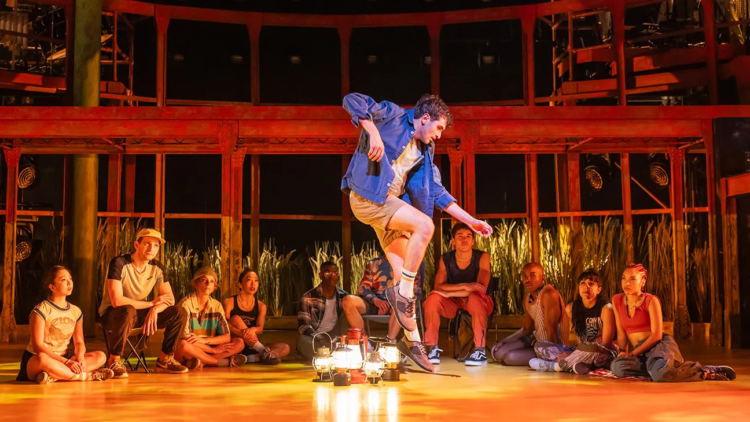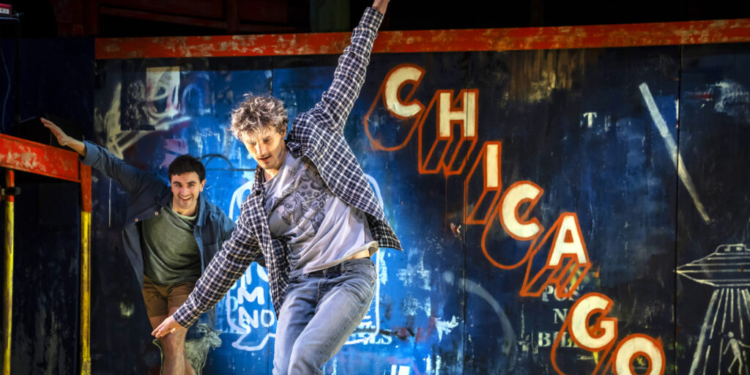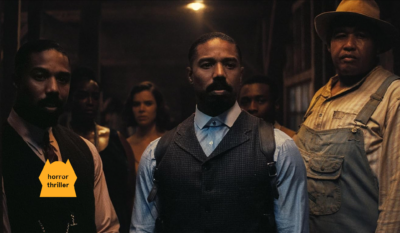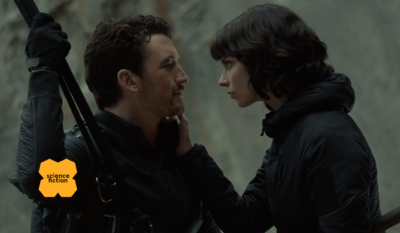Dance musical Illinoise takes the songs of Sufjan Stevens's album of the same name and reimagines them as a series of stories told around a campfire culminating in an emotional queer coming-of-age
Amongst Justin Peck‘s impressive and high energy choreography for Illinoise, the final new musical of the overstuffed and *insert RuPaul “meh” gif here* 2023-24 Broadway season, two men stand on stage hand-in-hand simply stepping to the side, forward, and back. Their hands are on their hearts and slowly their breathing comes in sync. We sit like this for nearly a minute. It's a quiet moment, one of many in the musical, that catapults it past simply a “dance play”. It's raw with meaning and drenched in queerness and love and anxiety and hope — a moment that had my inner gay child screaming.
Illinoise has been a personal project for choreographer-turned-director Justin Peck, who held the prestigious title of Resident Choreographer for the New York City Ballet before transitioning to choreographing for theater and film (he most recently choreographed Steven Spielberg's West Side Story remake). Like many millennials including yours truly, Sufjan Stevens and his concept album Illinois has been a nostalgic favorite — and regarded by many as one of the best albums of the 2000s. The twenty-two song magnum opus is a collection of stories inspired by people, places and events connected to the eponymous state.
ADVERTISEMENT
That celebration of storytelling is what Peck brought to book writer Jackie Sibblies Drury.
Together, they envisioned the songs as stories told by a group that found themselves together in an anonymous forest. But rather than using dialogue, the musical uses dance as its storytelling medium of choice.
The show's set is a mangle of scaffolding and trees with platforms housing the band and three vocalists above the stage donning butterfly wings (Elijah Lyons, Shara Nova, Tasha Viets-Vanlear) as if they're a queer Greek chorus narrating what's happening below (Legally Blonde the Musical, eat your heart out), crooning out Stevens's music with gorgeous harmonies and orchestral orchestrations by Timo Andres. The twelve-dancer cast is a troop of hikers gathered around a campfire made of lanterns. Their introduction is bright, energetic and joyful as they greet each other (“Come On! Feel the Illnoise!”). The beauty of Peck's choreography is its ease. Each dancer, though moving with the unit, feels like they're in their own unique body imbuing their personality into the uniformity. Each of them holds a notebook.
ADVERTISEMENT

Taking turns, they each tell a story from it set to one of Stevens's songs, putting it down at the foot of the stage as if activating a new world.
In “John Wayne Gacy, Jr.”, Alejandro Vargas puts a flashlight under his face like he's about to tell a ghost story. The stage darkens and we watch as the story of the eponymous serial killer comes to life in front of our eyes before Vargas's character relates the story to the skeletons in his own closet. When the emotion becomes too much, his fellow storytellers hold him as he calms down. In “Jacksonville”, Rachel Lockhart stomps out a hip-hop-tinged number that eventually adds Byran Tittle tap dancing his way across the stage. As the number goes on, Lockhart begins to mirror his moves. It is an energetic full company showstopper that feels like it has deeper meaning. Perhaps it's about the lessons we pass down from generation to generation to find ourselves stronger — Jacksonville, Illinois was a stop on the underground railroad, so the choice to have two black dancers lead the number feels intentional. After all, the opening line of the song is:
I'm not afraid of the black man running
He's got it right, he's got a better life coming
But the musical never tries too hard to imbue meaning on the numbers. Stevens has always been opaque about the meaning of his music. Peck, who also directs, adds enough context for you to find your own interpretation rather than telling you like many other dance musicals.
ADVERTISEMENT
The dance numbers range from intimate interpretive pieces to full-blown production numbers that are as thrilling and entertaining as any big brassy Broadway musical.
Lurking in the background, our protagonist Henry (Ricky Ubeda, the season 11 winner of So You Think You Can Dance?) is observing and shirking off the occasional goading to share what is in his notebook. Eventually, he gives in and for the final hour of the musical we see what led him to the campfire in the forest. On the back wall, a bit of graffiti tells us he's in a small town in the middle of nowhere with his best friend Carl (Ben Cook) and Carl's girlfriend Shelby (Gaby Diaz). There's clearly a tension between the three of them as their bodies twist and spin into and out of each other (“Decatur”). After Past Lives, Challengers and Passages love triangle are clearly in. However, the tension between Henry and Carl is palpable.
As any queer person can attest, in Henry's mind there's something potentially romantic between the men. A touch, playful wrestling, a near brush of the lips will send anyone into a spiral negotiating the potential queerness of their straight friend. During the endearing number “Chicago” the pair drive off to… well, Chicago in a swirl of flashlights that become the car and the city passing by before finding themselves in New York City where Henry meets Douglas (Ahmad Simmons). A gay man who sees Henry for who he is. Henry makes the choice to stay while Carl returns to their hometown (“To the Workers of the Rock River Valley Region”).
ADVERTISEMENT

The brilliance of Illinoise of using dance to tell this particular story is so much of the queer coming-of-age experience comes from body language.
Something the choreography uses to great affect. Like each of the dancers are spinning objects intersecting with each other in time and space grasping for something — sometimes literally each other or a ghost that disappears in a bit of stagecraft that I'll leave unspoiled. Brandon Stirling Baker‘s dynamic lighting design and Adam Rigg‘s minimalistic scenic design add to the ethereal effect. When life takes a turbulent turn, the stage uses the negative space to focus in on the details of the choreography. Not just the way bodies are moving, but how they're moving together.
In the end, Illinoise is about community and relationships. How those around us that we allow to understand our plights can figuratively and literally snap us out of our depressive psyches. Ubeda's performance, worthy of a Tony nomination, is one of a traumatized man finding those moments of light — and the people he trusts. When he's first introduced, Henry's memories are literally represented by orbs held above Carl, Shelby and Douglas's heads that swirl from Henry's mind onto the stage (“Three Stars”). His expressiveness in his dance finds its way to his face grasping for empathy that he gets in the form of tears streaming down the faces of the audience (at the very least from a 30-year-old gay man in the second row understanding every emotion). What Illinoise presupposes is that speaking (no matter what the medium) is tantamount to healing. And over a beautiful, engrossing, heart-wrenching but ultimately uplifting 90 minutes, you feel it.
ADVERTISEMENT
More movies, less problems
- Jordan Peele Unleashes the First Trailer for ‘HIM'
- ‘Sinners' is the best movie of the year | movie review
- Romantic sci-fi thriller ‘The Gorge' hits its mark | movie reivew
Hey! I'm Karl. You can find me on Twitter and Letterboxd. I'm also a Tomatometer-approved critic.
💌 Sign up for our weekly email newsletter with movie recommendations available to stream.
ADVERTISEMENT
Hey, I'm Karl, founder and film critic at Smash Cut. I started Smash Cut in 2014 to share my love of movies and give a perspective I haven't yet seen represented. I'm also an editor at The New York Times, a Rotten Tomatoes-approved critic, and a member of the Online Film Critics Society.

